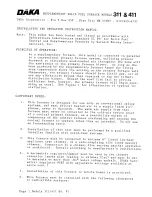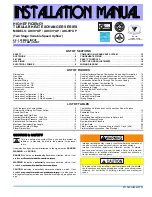
6
Clearances and Accessibility
Installations must adhere to the clearances to combustible
materials for which this furnace has been design certified.
The minimum clearance information for this furnace is pro-
vided on the unit’s clearance label. These clearances
must be permanently maintained. In addition to the re-
quired clearances to combustible materials, a 36-inch
minimum for clearance servicing must be available in
front of the unit. Unit positioning is referenced as follows:
TOP
BOTTOM
SIDE
SIDE
SIDE
TOP
BOTTOM
Upflow Counterflow Horizontal
Air Requirements
WARNING
To avoid death, personal injury or property damage,
enough fresh air for proper combustion and
ventilation of flue gases must be provided to this
furnace. Most homes require outside air to be
supplied into the furnace area.
Improved construction and additional insulation in homes
have reduced the heat loss and made these homes
much tighter around doors and windows so that air
infiltration is minimal. This creates a problem to supply
ventilation and/or combustion air for gas fired or other
fuel burning appliances. Any use of appliances that pull
air out of the house (clothes dryers, exhaust fans,
fireplaces, water heaters, non-direct vent furnaces, etc.)
increases this problem and appliances could be starving
for air.
If fuel-burning appliances are starved for air, the flue
gases which these appliances produce as they operate
may not vent outdoors properly, but remain in the home
instead. These flue gases may include carbon monoxide.
WARNING
Death or personal injury from asphyxiation can result
from exposure to carbon monoxide.
Carbon monoxide or “CO” is a colorless and odorless gas
produced when fuel is not burned completely or when the
flame does not receive sufficient oxygen.
Be aware of these air starvation signals which
indicate conditions that may result in carbon monox-
ide or that carbon monoxide may be present:
1. Headaches-Nausea-Dizziness, Flu-Like Symptoms.
2. Excessive humidity-heavily frosted windows or a
moist “clammy” feeling in the home.
3. Smoke from a fireplace will not draw up the chimney.
4. Flue gases that will not draw up the appliance vent
pipe.
Combustion Air (Non-Direct Vent/Single
Pipe)
WARNING
It is vitally important that the furnace have proper
venting. To prevent possible death or personal injury
due to asphyxiation, this furnace must never be
common vented with another gas fired appliance.
Any alteration to any venting system must be in
accordance with local and national codes, and the
manufacturer's instructions.
In non-direct vent installations (single pipe), the air for
combustion and ventilation can typically be obtained from
the surrounding unconfined space or louvered closet
door. Observe the following precautions concerning air
availability:
• When a furnace is installed in a closet and the
closet door is louvered, DO NOT OBSTRUCT
LOUVERS. Louvers must be open and clear to
provide combustion air to the furnace.
• When a furnace is installed in a confined space
within a home and the air for combustion and venti-
lation enters the space through ducts from the out-
side, be sure to routinely check the entering and
outlet, grilled openings to verify that they are always
clear and clean.
• Do not partition off a small area around the furnace
utilizing a non-louvered door. This could obstruct
the combustion air from reaching the furnace.
• Do not allow the furnace’s air intake (top or side) to
become blocked.
• The combustion and ventilation air must never
come from a corrosive atmosphere.
General Information
Summary of Contents for GULA
Page 17: ...17...




































